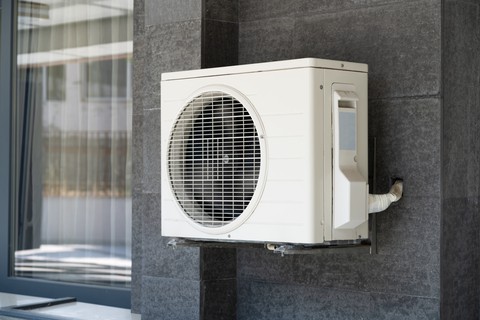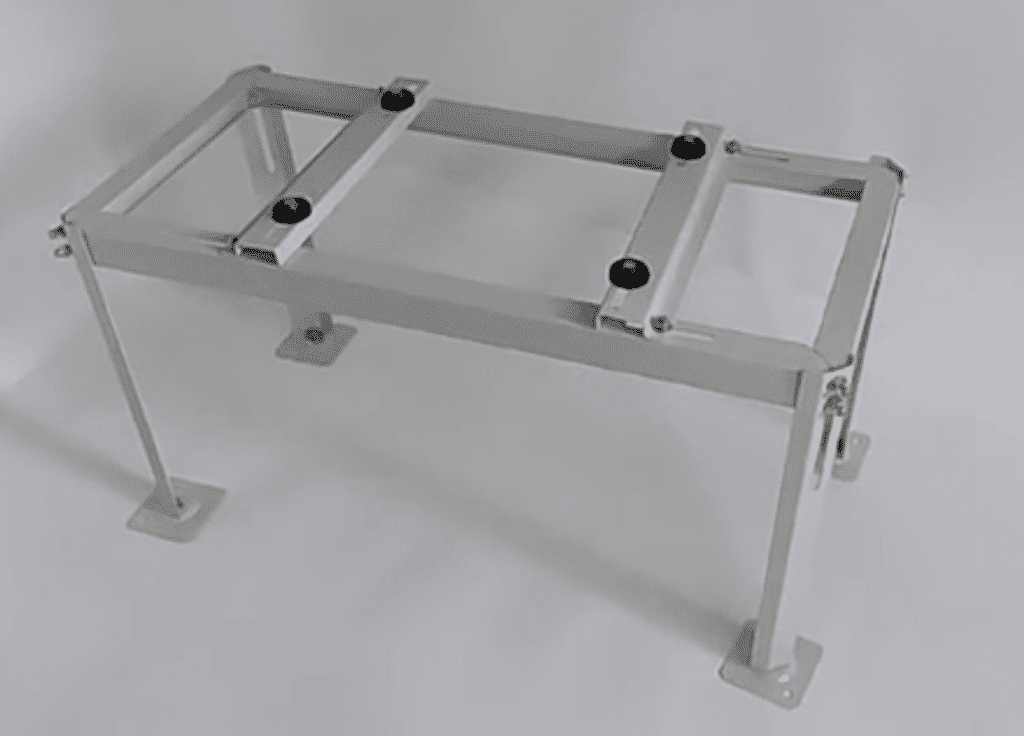Introduction – Heat Pumps For Homes
A heat pump is an electrically powered device that extracts heat from one place and transfers it to another. The heat pump is one of the most energy efficient ways to heat and cool your home and hence is worth covering for its inherently carbon footprint reducing properties.
In 2022, of the 1,022,000 single family homes that were built, more than 43% of them were constructed with a heat pump already installed, which speaks to the incredible growing popularity of these highly efficient heating and cooling devices. Most of these were air source devices. Although 2022 didn’t record geothermal units in previous years they comprised only 2% of heating.

Photo 227260223 / Heat Pump © Andrey Popov | Dreamstime.com
Copy
Traditional heaters generate heat by converting energy source into heat. For example, a natural gas fired furnace burns the gas to power a flame which gives emits heat. Another example, an electric heater passes electricity through a heating element that makes it hot and radiate heat.
In contrast, a heat pump pushes a refrigerant gas from the outside to inside, expanding and compressing the gas in cycles. Upon expansion it absorbs heat, and upon compression it releases the heat back.
Cold Climate Heat Pumps – Now Work In Sub-Zero Fahrenheit Temperatures
Before the early 2000s, heat pumps would be more common in the Southern states of the US because heating demands were less than colder climates in the Northeast or Great Lakes regions. Then in the mid 2000s, a number of manufacturers developed “cold climate heat pumps” which work in very low temperatures. Big names in this space include Mitsubishi, Daikin, Fujitsu, Samsung, and later, an American brand Lennox which is said to rely on Chinese manufacturer Gree.
Heat Pump Size By Square Footage Of Home
The conventional thought is that at least 20 BTUs are needed per square foot of a home. With this information, we can size the heat pump in terms of it being 1-5 ton appliance. Each ton is able to move 12,000 BTU per hour from the outside to the inside. Here is one for your house by square meters.
| House size | Heat Needed (BTU) | Heat Pump Size |
| 100 m2 (1076 ft2) | 21,520 BTU | 2 tons |
| 150 m2 (1614 ft2) | 32,280 BTU | 3 tons |
| 200 m2 (2152 ft2) | 43,040 BTU | 4 tons |
| 250 m2 (2690 ft2) | 53,800 BTU | 5 tons |
We developed a table if your house is measured in square feet.
| House size | Heat Needed (BTU) | Heat Pump Size |
| 1000 ft2 (92 m2) | 20,000 BTU | 2 tons |
| 1500 ft2 (139 m2) | 30,000 BTU | 3 tons |
| 2000 ft2 (184 m2) | 40,000 BTU | 4 tons |
| 2500 ft2 (232 m2) | 50,000 BTU | 5 tons |
There’s a good chance your house is bigger or smaller. Simply convert the area to square feet and multiple by 20 BTUs. Then check how many tons you’ll need to cover the total BTU requirement. Each ton will cover 12,000 BTU. For example in the table above, at 1500 ft2 the required heat is 30,000 BTU which translates to 3 tons because 3 tons will move 36,000 BTU (3 x 12,000 BTU = 36,000 BTU).
There’s also climate to factor into the calculation. Instead of 20 BTU per square foot, the number is bumped up to 35 and even 50 BTU per square foot for colder climate regions like New York to New England. The information below is used to construct new tables for the heat needed.
| Climate Type | BTU of heat Per Square Foot |
|---|---|
| Cold (Minnesota, North Dakota, Maine, Alaska) | 50 |
| Moderate (New York, Virginia, Oregon) | 35-40 |
| Warm (Florida, Texas, Southern California) | 20-30 |
There Are Two Types Of Heat Pumps Based On The Way Each Operates
1. Air-Source Heat Pumps
Air-source heat pumps are the most common type of heat pump. They work by transferring heat from the air outside to the air inside your home. Older generation air-source heat pumps were most effective in mild to moderate climates. However, newer generation heat pumps work even in very cold climates.
The Mitsubishi mini-split heat pump is rated to operate at 76% of capacity even if the exterior temperature drops to -13 F. That means hot air will be pumped into the house from the outside, despite the outside temperature being so low. Finally, we remark here that should the exterior temperature be too low and your appliance is failing, certain brands also carry an “emergency heat” mode which switches the unit to standard electric resistive heating
2. Ground-Source Heat Pumps
Ground-source heat pumps are less common than air-source heat pumps, but they are very efficient. Ground-source heat pumps transfer heat from the ground to your home. Ground-source heat pumps are most effective in moderate to cold climates. They are also a type of geothermal system because they rely on heat trapped deep underground.
Heat Pumps Are Efficient and Reduce Your Carbon Footprint
Heat pumps are highly efficient, being able to move 2.5 to 3 times more heat than can be generated with the same energy using an old fashioned radiative heater. Because of the efficiency, it saves money as well as reduces the carbon footprint of a household.
Heat pumps use physics to be more efficient for heating and cooling than heaters that use combustion to generate heat or air conditioners that that use compressors to cool. In heating mode, it extracts heat from the air, ground, or water and transfers it into your home. In cooling mode, it transfers heat from your home to the air, ground, or water.
Water-source heat pumps are the least common type of heat pump. Water-source heat pumps transfer heat between your home and a water source, such as a river or lake. But where would we find a water source deep enough to retain heat in winter? Water-source heat pumps are most effective in moderate to cold climates.
There are a few caveats to heat pumps, especially concerning the brand or model fit to your home and climate. Weighing the pros and cons of the heat pump will lead to you a better choice than to accept blindly the recommendation of the HVAC technician.
Cost To Set Up A Heat Pump For Your Home
The cost of a heat pump varies depending on the type of heat pump, the size of your home, and the climate. Air-source heat pumps are the least expensive type of heat pump to install. Ground-source heat pumps are more expensive to install, but they are more efficient. Water-source heat pumps are the most expensive type of heat pump to install.
In general, the heat pump unit costs between $3,000 and $5,000 and the installation cost is considerable as well. The main body of the unit is called the “condenser unit” because of the way we described above in its handling of the coolant gas. The cost of a heat pump varies depending on the type of heat pump, the size of your home, and the climate. Don’t forget, ductwork or mini-split air handler units will incur additional costs. These are not trivial! Older homes will not have ductwork and you will have to figure out what kind and whether you want to install these.
Each air handler unit will cost $500-$1000. There will be several factors that control how many air handlers your home needs. Think of each “space” as requiring its own air handler. For example upstairs each bedroom would need one, and downstairs a joint kitchen and dining room would need one. People usually don’t cool their bathrooms and hallways separately although you’re certainly welcome to add those.
The advantage of having separate air handler units for each space is efficiency. Because the heating will be controlled on a zone-by-zone basis, when it reaches a desired temperature, the air handler will stop the flow of warm air and reduce the load on the condenser unit.
Ductwork costs are variable depending on the amount you want to install. But as a rough rule of thumb, for a 2000 sq ft house, plan for $10,000 to be allocated to the ductwork. The true costs will depend on whether you want the ductwork to reach all the way to the 1st floor or if just the upstairs uses it, with ducts running from the attic space to the ceiling of the 2nd floor. Obviously the less ductwork the cheaper your project.
A fancy VRF heat pump thats more common in commercial settings will set you back more – the additional benefit is more efficiency heating and cooling but its not clear what the cost-benefits are for a residence.
Ductwork Vs Mini-Split
Ductwork is necessary for distributing heat throughout your home with a heat pump. If you do not have existing ductwork in your home, you will need to have ductwork installed. Ductwork can be expensive to install. If you are not planning to have ductwork installed, you can consider a mini-split heat pump. Your HVAC technician will evaluate your home for which choice, or even a hybrid, makes the most sense.
A mini-split heat pump is a type of heat pump that does not require ductwork. Mini-split heat pumps are less expensive to install than ducted heat pumps. Mini-split heat pumps are most effective in mild to moderate climates.
How Does A Heat Pump Work?
Heat pumps use a refrigerant to transfer heat between your home and the outside air, ground, or water. The refrigerant is a substance that evaporates and condenses easily. The refrigerant absorbs heat when it evaporates and releases heat when it condenses.
The refrigerant is circulated through a system of coils. The coils are located inside and outside your home. In heating mode, the refrigerant absorbs heat from the air, ground, or water and transfers it into your home. In cooling mode, the refrigerant transfers heat from your home to the air, ground, or water.
Placement Of Heat Pump Outside The Home
The condenser portion of the heat pump should be placed in a location that is away from any sources of heat, such as a sunny spot or a spot near a heat source, such as a furnace. The heat pump should also be placed in a location that is protected from the wind. You will be required to take out foliage near the heat pump, giving it enough room to radiate away the hot and cold air.
Anything that blocks the flow of air is only going to make your device operate less efficiently! One big concern is the noise from the heat pump and the vibrations. If the entire condenser is put onto a concrete block that’s separated from the house, then you should be pretty insulated from the noise.
However you can also opt to hang it on the side of the house to avoid putting in an ugly concrete slab. The best place to hang it would be on a concrete part of the house that’s rigidly rooted to the foundation and doesn’t vibrate. Just install brackets into the concrete for the wall-mount and place the condenser unit on the wall-mount.

How To Choose A Heat Pump For Your Home
When choosing a heat pump for your home, you should consider the following factors:
1. The type of heat pump
2. The size of your home
3. The climate
4. The cost
5. The installation
Heat Pumps Vs Air Conditioners
Heat pumps and air conditioners are both types of HVAC systems. Heat pumps can be used for both heating and cooling, while air conditioners can only be used for cooling. In fact, in Australia, a heat pump running in heat mode is referred to as “reverse-cycle air conditioner”.
Heat Pumps Vs Furnaces
Heat pumps are way more energy efficient than furnaces. In fact, in a study in wintry New England of the United States, even compared to high efficiency natural gas furnaces, the heat pump is about 30% more cost efficient. That was comparing energy prices in 2018-2020 so your own experience will vary depending on your gas prices and grid prices.
In early 2022 the Russia-Ukraine conflict has really up-ended energy prices so that natural gas has become 3 to 10 times more expensive. At the same time, electricity prices have bumped up too because the grid uses natural gas as part of its energy source.
We recommend that you check with a local energy expert to make these estimates. We expect Europe to feel the pinch of the 2022 winter and urge our friends there to prepare for it as much as possible, even taking action personally for example getting solar power and propane for emergencies.
Installation
Heat pumps should be installed by a qualified HVAC technician.
Preparing Your Home For Installation
Before your heat pump is installed, you should take the following steps to prepare your home:
1. Choose a location for the heat pump. The heat pump should be placed in a location that is away from any sources of heat, such as a sunny spot or a spot near a heat source, such as a furnace. The heat pump should also be placed in a location that is protected from the wind. Shrubbery is cleared from the site to allow air exchange.
2. Prepare the installation site. The installation site should be level and should have a solid foundation.
3. Install the ductwork. If you are having a ducted heat pump installed, you will need to have ductwork installed. Ductwork can be expensive to install because it runs in tight spaces hidden from view to connect the air handler typically in the attic to the rooms on the lower floors.
4. Install the mini-split. If you are having a mini-split heat pump installed, you will need to have a hole drilled through your home’s exterior wall. The hole should be big enough to accommodate the mini-split’s condenser. It’s also possible to hide it inside the wall although that will incur more time and cost!
5. Install the concrete slab. If you are having a ground-source heat pump installed, you will need to have a concrete slab installed. The concrete slab should be big enough to accommodate the heat pump’s coils. It’s also possible to wall-mount it provided you have a concrete wall that resists vibrations.
Heat Pump Problems And Maintenance
Heat pumps need maintenance and repair just like any other type of heating device. To keep the system running efficiently, it is important to regularly check the air filter, clean the condenser coils, and inspect the ductwork for any blockages or leaks. Additionally, the refrigerant levels should be checked and topped up as needed.
Properly maintaining the system will help to ensure that it runs as efficiently as possible and help to prevent any potential breakdowns. In the event of a breakdown, a qualified HVAC technician should be called to assess and repair the system. However, if you want to get a better sense for what these issues entail and what it takes to fix them, we have also covered common heat pump problems.
Well-Known Manufacturers Of Heat Pumps
There are many manufacturers. Some well-known domestic USA ones include Carrier, Trane, Lennox, and Rheem.
- Carrier: An established name in the HVAC industry, Carrier offers a wide variety of heat pumps suitable for different climates and efficiency needs. They are known for their reliability, longevity, and technological innovation.
- Trane: Renowned for its robust and efficient products, Trane produces heat pumps designed for durability and high performance, even under demanding conditions. Trane’s systems often feature advanced control and diagnostic capabilities.
- Lennox: Lennox stands out for their focus on energy-efficiency and sustainability. Their heat pumps offer excellent performance and can lead to significant energy savings, aligning with green initiatives and reducing environmental impact.
- Rheem: Rheem is recognized for providing a balance of quality and affordability. Their heat pumps are popular for their consistent performance, ease of use, and solid warranty terms.
In the global market, numerous manufacturers produce high-quality heat pumps. Some of these companies have a strong international presence, while others are more region-specific. Here are a few notable non-U.S. manufacturers:
- Daikin: Based in Japan, Daikin is one of the world’s leading manufacturers of HVAC products. They are known for their innovative, energy-efficient heat pumps that cater to a wide range of climates and needs.
- Mitsubishi Electric: Another major Japanese company, Mitsubishi Electric produces highly efficient and reliable heat pumps. Their units are designed with advanced features, providing superior climate control and energy savings.
- Bosch: This German brand is recognized worldwide for its high-quality appliances and HVAC solutions. Bosch offers a range of heat pumps that are durable, efficient, and technologically advanced.
- LG: South Korean company LG is known for its diverse portfolio of electronics and home appliances, including efficient and innovative heat pumps.
- Vaillant: A family-owned company based in Germany, Vaillant is one of Europe’s largest producers of heating, cooling, and hot water products, including a range of reliable and efficient heat pumps.

Anne Lauer
Anna Lauer is a writer, gardener, and homesteader living in rural Wisconsin. She has written for Mother Earth News, Grit, and Hobby Farms magazines. Anna is writing a new book about growing your food for free and an ultimate guide to producing food at little to no cost. When she’s not writing or gardening, Anna enjoys spending time with her husband and two young daughters.
